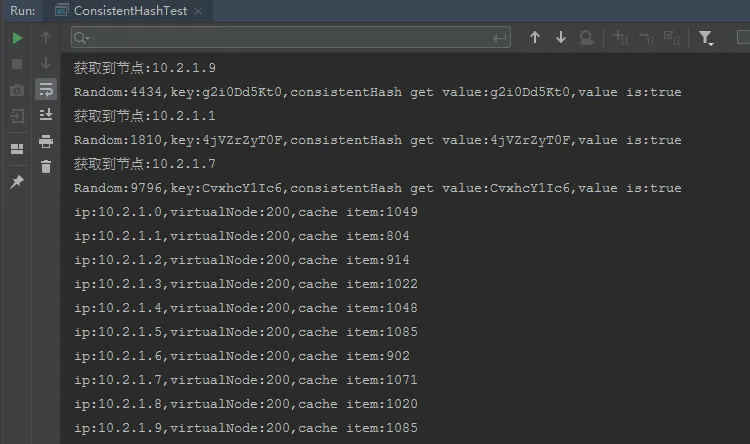CompletableFuture之控制时间
题目
有一个消息发送接口MessageService.send(String message),每次消息发送需要耗时2ms;
基于以上接口,实现一个批量发送接口MessageService.batchSend(List messages);
要求如下:
1)一次批量发送消息最大数量为100条
2)批量发送接口一次耗时不超过50ms。
3)要求返回消息发送是否成功的结果。
解决
思路:将list进行分割,然后遍历分割后的list,创建任务,然后等全部执行完
1
2
3
4
5
| <dependency>
<groupId>com.google.guava</groupId>
<artifactId>guava</artifactId>
<version>30.1-jre</version>
</dependency>
|
使用了guava进行list的分割
代码:
1
2
3
4
5
6
7
8
9
10
11
12
13
14
15
16
17
18
19
20
21
22
23
24
25
26
27
28
29
30
31
32
33
34
35
36
37
38
39
40
41
42
43
44
45
46
47
48
49
50
51
52
53
54
55
56
57
58
59
60
61
62
63
64
65
66
67
68
69
70
| package com.fang.other;
import com.google.common.collect.Lists;
import java.util.ArrayList;
import java.util.List;
import java.util.concurrent.*;
public class Test {
public static void main(String[] args) {
ArrayList<String> list = new ArrayList<>();
for (int i = 0; i < 100; i++) {
list.add(String.valueOf(i));
}
long start = System.currentTimeMillis();
batchSend(list);
long end = System.currentTimeMillis();
System.out.println("方法耗时:" + (end - start));
}
private static final ThreadPoolExecutor executor = new ThreadPoolExecutor(10, 10, 10, TimeUnit.SECONDS, new ArrayBlockingQueue<>(10));
public static boolean batchSend(List<String> messages) {
List<List<String>> partition = Lists.partition(messages, 20);
List<CompletableFuture> futures = new ArrayList<>();
for (List<String> one : partition) {
CompletableFuture<Boolean> future = CompletableFuture.supplyAsync(() -> {
for (String res : one) {
if (!send(res)) return false;
}
return true;
},executor);
futures.add(future);
}
CompletableFuture<Void> allOf = CompletableFuture.allOf(futures.toArray(new CompletableFuture[0]));
try {
allOf.get();
} catch (InterruptedException e) {
throw new RuntimeException(e);
} catch (ExecutionException e) {
throw new RuntimeException(e);
}
return true;
}
public static boolean send(String message) {
try {
Thread.sleep(2);
return true;
} catch (InterruptedException e) {
throw new RuntimeException(e);
}
}
}
|
一致性hash
首先定义一个节点类,实现数据节点的功能,具体代码如下:
1
2
3
4
5
6
7
8
9
10
11
12
13
14
15
16
17
18
19
20
21
22
23
24
25
26
27
28
29
30
31
32
33
34
35
36
37
38
39
40
41
42
43
44
45
46
47
48
49
50
51
52
53
54
55
56
57
58
| public class ConsistentHash {
private final TreeMap<Integer, Node> hashRing = new TreeMap<>();
public List<Node> nodeList = new ArrayList<>();
public void addNode(String ip) {
Objects.requireNonNull(ip);
Node node = new Node(ip);
nodeList.add(node);
for (Integer virtualNodeHash : node.getVirtualNodeHashes()) {
hashRing.put(virtualNodeHash, node);
System.out.println("虚拟节点[" + node + "] hash:" + virtualNodeHash + ",被添加");
}
}
public void removeNode(Node node){
nodeList.remove(node);
}
public Object get(Object key) {
Node node = findMatchNode(key);
System.out.println("获取到节点:" + node.getIp());
return node.getCacheItem(key);
}
public void put(Object key, Object value) {
Node node = findMatchNode(key);
node.addCacheItem(key, value);
}
public void evict(Object key) {
findMatchNode(key).removeCacheItem(key);
}
|
1
2
3
4
5
6
7
8
9
10
11
12
13
|
private Node findMatchNode(Object key) {
Map.Entry<Integer, Node> entry = hashRing.ceilingEntry(HashUtils.hashcode(key));
if (entry == null) {
entry = hashRing.firstEntry();
}
return entry.getValue();
}
|
}
如上所示,通过TreeMap的ceilingEntry() 方法,实现顺时针查找下一个的服务器节点的功能。
哈希计算方法比较常见,网上也有很多计算hash 值的函数。示例代码如下:
1
2
3
4
5
6
7
8
9
10
11
12
13
14
15
16
17
18
19
20
21
22
23
24
25
26
| public class HashUtils {
public static int hashcode(Object obj) {
final int p = 16777619;
int hash = (int) 2166136261L;
String str = obj.toString();
for (int i = 0; i < str.length(); i++)
hash = (hash ^ str.charAt(i)) * p;
hash += hash << 13;
hash ^= hash >> 7;
hash += hash << 3;
hash ^= hash >> 17;
hash += hash << 5;
if (hash < 0)
hash = Math.abs(hash);
return hash;
}
}
|
一致性哈希算法实现后,接下来添加一个测试类,验证此算法时候正常。示例代码如下:
1
2
3
4
5
6
7
8
9
10
11
12
13
14
15
16
17
18
19
20
21
22
23
24
25
26
27
28
29
30
31
32
33
34
35
36
37
38
39
40
41
42
43
44
45
46
47
48
49
50
| public class ConsistentHashTest {
public static final int NODE_SIZE = 10;
public static final int STRING_COUNT = 100 * 100;
private static ConsistentHash consistentHash = new ConsistentHash();
private static List<String> sList = new ArrayList<>();
public static void main(String[] args) {
for (int i = 0; i < NODE_SIZE; i++) {
String ip = new StringBuilder("10.2.1.").append(i)
.toString();
consistentHash.addNode(ip);
}
for (int i = 0; i < STRING_COUNT; i++) {
sList.add(RandomStringUtils.randomAlphanumeric(10));
}
for (String s : sList) {
consistentHash.put(s, s);
}
for(int i = 0 ; i < 10 ; i ++) {
int index = RandomUtils.nextInt(0, STRING_COUNT);
String key = sList.get(index);
String cache = (String) consistentHash.get(key);
System.out.println("Random:"+index+",key:" + key + ",consistentHash get value:" + cache +",value is:" + key.equals(cache));
}
for (Node node : consistentHash.nodeList){
System.out.println(node);
}
consistentHash.addNode("10.2.1.110");
for(int i = 0 ; i < 10 ; i ++) {
int index = RandomUtils.nextInt(0, STRING_COUNT);
String key = sList.get(index);
String cache = (String) consistentHash.get(key);
System.out.println("Random:"+index+",key:" + key + ",consistentHash get value:" + cache +",value is:" + key.equals(cache));
}
for (Node node : consistentHash.nodeList){
System.out.println(node);
}
}
}
|
运行此测试,输出结果如下所示:

